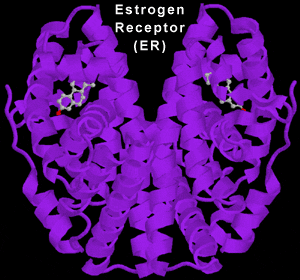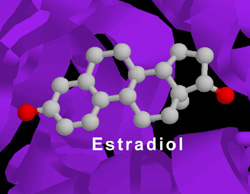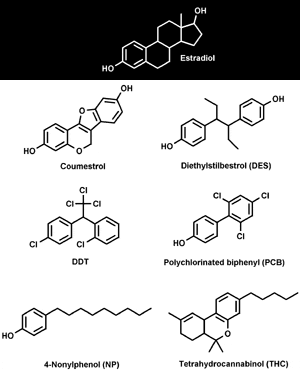 |
|
||||||||||
|
|
|||||||||||
Endocrine-Disrupting CompoundsManmade Hormone MimicsHuman sperm counts might be falling. Pregnant women are warned to avoid nail polish. Fish may store dangerous chemicals in their fat. Male alligators can’t reproduce because their reproductive organs are abnormal. What’s going on?
EDCs are typically manmade (the plant estrogens in soy are an exception) and occur in the environment, often at very low levels. In some cases, even compounds that have been banned persist both in the environment and in the fat of organisms and make their way through the food web. Originally, decisions about acceptable environmental levels of these compounds were typically based on their carcinogenic effects in adult animals. Researchers exposed animals to increasingly lower levels of a particular compound until they found a concentration that did not produce an observable adverse effect (e.g., a tumor). That concentration would then be divided by a certain number, such as 100, to identify what would be considered a safe level of exposure. But these “safe” levels may be safe only for adult animals; much lower concentrations of these compounds may have profound effects on embryonic development (and not by causing cancer). For example, a dose of the banned pesticide chlordane, even at extremely low environmental levels, can strongly affect a developing embryo. Yet an adult exposurd to dimilar concentrations of chlordane may not be visibly affected by subtle hormone-like changes. Sex and the Red-Eared Slider Turtle
In the red-eared slider turtle, extremely low concentrations of chlordane (parts per billion) can alter the sex of developing turtle embryos from male to female. In this species, incubation temperature determines sex, most likely by triggering a pathway that ends in steroid activity to direct sexual development. High temperatures may trigger a pathway that results in estrogen production and resulting in female development. Many EDCs, including chlordane, can override a male-producing temperature and trigger the female-determining pathway. In other words, a compound like chlordane makes turtles female even when the eggs have incubated at a male-producing temperature. Compounds that have this effect include: chlordane, some PCBs, and some metabolites of the banned pesticide DDT.
How do these compounds shift sex determination? They may simply mimic steroid hormones, which operate in an exquisitely sensitive environment, especially during embryogenesis. Steroid hormones act at low concentrations by binding a nuclear receptor: the binding activates the receptor, which then goes to work as a transcription factor to activate DNA transcription and the eventual production of proteins. Proteins that are produced as a result of estrogen receptor activation include growth factors. Estrogen receptors are a little promiscuous and not too picky about what activates them, and many EDCs seem to be capable of binding estrogen receptors. Thus, the organism may be making its own estrogen as well as experiencing the effects of these estrogen mimics. It is also possible that estrogen receptor activation results in a positive feedback loop to generate more estrogen receptor. In the case of a developing red-eared slider turtle, the result is an increased estrogenic effect strong enough to trigger female development in the face of a male temperature trigger. Endocrine Disruption
Direct mimicry is not the only possible way EDCs operate. Any step in the pathways of steroid production, regulation, or activity is a potential target for disruption. For example, estradiol, the prevalent form of estrogen in humans, is made through a multi-step process that begins with cholesterol and ends with the biometabolization of testosterone into estradiol. The enzyme responsible for converting testosterone into estradiol is aromatase. A compound that interferes with either aromatase activity or aromatase levels within the cell can affect estrogen levels. Additionally, a compound that interferes with the activity of estradiol can alter how estradiol functions as a hormone. In this single example of a steroid (estradiol) and its related enzyme (aromatase), there are many potential steps for disruption. On a broader scale, because there are a large the number of endocrine-involved enzymes, sex steroid hormones, and other hormones (including thyroid hormones and hormones governing the immune system), the possibilities for disruption and the ensuing effects on an organism are almost endless. The effects of these compounds also are numerous and occur at many levels, from sex determination to behavior. For example, estrogen is thought to be necessary for the proper masculinization of the mammalian brain and thus for the proper expression of masculine behavior in rats. However, female rats exposed in utero to a powerful synthetic estrogen mimic known as diethylstilbestrol (DES) exhibit masculinized behavior because DES strongly binds the estrogen receptor and elicits a concordantly strong response. Proper sexual behavior is integral to successful reproduction for many species: a female rat that acts like a male will not successfully reproduce. Thus, if a compound disrupts the hormones that help to hard-wire this sexual behavior, reproductive success for that species will diminish. Predicting Effects of Suspected EDCs
Using structural information to predict which suspected EDCs are of great concern is difficult because of the lack of selectivity on the part of some steroid receptors. Many of these compounds have a chlorine component and hydrocarbon rings, but the similarities stop there, and researchers have had a hard time predicting or identifying potent EDCs. This discrimination is further hampered by the potential for disruption at many different steps in an endocrine pathway. Therefore, much of the current research in this field focuses on identifying the compounds that act as EDCs, and the levels at which they produce undesired effects. To this end, esearchers have developed tests that can quickly and accurately examine hundreds of compounds. Some of these assays use animals as models, while others are test-tube, or in vitro, assays. One example of an in vitro assay is a straightforward assessment of whether or not a compound can bind a steroid receptor. In this competitive-binding assay, a hormone receptor is bound to a solid matrix. The source of the receptor can be either crude cellular extract of tissue known to contain the receptor, or a purified sample of receptor. Next, test compounds are examined for their ability to compete for binding to the receptor against a labeled control molecule with a strong affinity for the receptor. For example, in a competitive binding assay using the estrogen receptor, tritium-labeled estradiol is used. Suspected EDCs are tested separately for their ability to outcompete the radiolabeled estradiol for receptor. As a positive control in the estrogen-receptor binding assay DES is used, which outcompetes estradiol for the receptor because its binding affinity for estrogen receptor is 100 times greater than estradiol’s. Researchers quantitate the degree of radioactivity that the receptor can effectively bind and compare this to a negative control (such as a compound known to not interact with the receptor. The more strongly a compound can bind the receptor, the more it will displace (outcompete) labeled estradiol and decrease the radioactivity. The DES positive control tube will show no radioactivity because DES completely outcompetes all radiolabeled estradiol. A compound with a receptor affinity like that of DES will diminish radioactivity completely, while a compound that does not bind estrogen receptor will not affect radioactivity at all. A competitive binding assay can be done with other hormones and receptors, including androgens and androgen receptors. In vivo assays involve animals rather than test tubes. Although in vitro assays provide a lot of information about the behavior of these compounds, the key question is, "What effects do EDCs have in the animals themselves?" No single assay so far is enough to identify all the compounds because of the many ways these chemicals operate and because their effects in one species can differ from their effects in another species. For example, DDE (a metabolite of DDT) does not have an estrogenic effect in the American alligator, but it acts as an estrogen in the red-eared slider turtle. Because of the red-eared slider turtle's adaptation of temperature-dependent sex determination that is apparently sensitive to estrogenic effects, it has provided one good animal system for assessing EDCs. Because estrogen is considered to be the endpoint of high temperatures, compounds that mimic estrogens will have the same effect as high temperature: females will develop. In a red-eared slider turtle assay, a suspected compound is applied to the eggshell in a predetermined concentration, and eggs are incubated to hatching at a temperature that normally produces males. The sex of hatchlings is assessed, and compounds that in some way are estrogenic will produce a larger fraction of females than untreated controls. Many compounds and combinations of compounds have been identified as estrogenic using this assay. Other in vivo assays involve, for example, exposing mice or rats in utero to suspected EDCs and assessing their effects on behavior—especially sexual behavior—or learning. Studies on mammals may provide the strongest link to effects in humans. EDCs are suspected of effecting many species, but it is often difficult to prove a direct link, especially in humans. In people, PCBs are thought to affect neurological development: they are suspected of causing birth-weight, size, and I.Q. deficits in children of exposed mothers; and children of PCB-exposed mothers also appear to have behavioral deficiencies. In some cases of PCB exposure, mothers ingested the compounds by eating contaminated fish. Other EDCs are suspected of causing problems that run the gamut from low sperm counts in men to early onset of puberty in young girls. But a great deal of controversy exists over whether these compounds truly cause the disruptions blamed on them. Nevertheless, research to date has shown unequivocally that these compounds can disrupt some endocrine pathways in many species. |
 |
 |
Copyright 2006, John Wiley & Sons Publishers, Inc. |
 |
 |
 PCBs,
DDT, chlordane, phthalates. For years researchers have known of their potentially
dangerous effects in animals and humans. Some of these compounds–such as
the pesticide DDT–are known carcinogens and have been banned for years,
but they still persist in the environment. Others–such as the phthalates
(plasticizers) found in nail polish–are still found in products we use regularly.
Although some of these chemicals have known carcinogenic effects in adult animals,
a greater issue may be their effects in embryonic animals; concentrations that
have no effect in adults can have profound effects on a developing organism. Researchers
have identified more and more examples of these effects, especially on the body
systems that hormones govern, including the reproductive, thyroid, and immune
systems. Because these compounds often disrupt hormonal pathways, they are known
as endocrine-disrupting compounds, or EDCs.
PCBs,
DDT, chlordane, phthalates. For years researchers have known of their potentially
dangerous effects in animals and humans. Some of these compounds–such as
the pesticide DDT–are known carcinogens and have been banned for years,
but they still persist in the environment. Others–such as the phthalates
(plasticizers) found in nail polish–are still found in products we use regularly.
Although some of these chemicals have known carcinogenic effects in adult animals,
a greater issue may be their effects in embryonic animals; concentrations that
have no effect in adults can have profound effects on a developing organism. Researchers
have identified more and more examples of these effects, especially on the body
systems that hormones govern, including the reproductive, thyroid, and immune
systems. Because these compounds often disrupt hormonal pathways, they are known
as endocrine-disrupting compounds, or EDCs.

